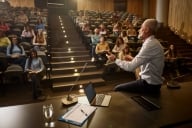You have /5 articles left.
Sign up for a free account or log in.
ORLANDO — When advocates for students with disabilities asked Stephen Rehberg, an associate academic professional at Georgia Tech’s Center of Enhanced Teaching and Learning, to help create workshops to teach science and technology faculty members how better to accommodate disabled students, Rehberg’s answer was simple: “No.”
“Trying to teach faculty about accessibility is a dead end,” Rehberg said last week, during a session as Blackboard’s annual user conference here. “They’re not going to come to the workshops, and [if] they get there, they’re going to glaze over. I said, ‘I’m not going to waste my time or the grant money.’ ”
Instead, Rehberg made a counter-proposal to his suitors from the Center for Assistive Technology and Environment Access: He would design a STEM class catering to the needs of disabled students with the hypothesis that it would improve engagement for everybody — specifically, students in huge lecture courses.
“At Georgia Tech, we have many classes that are 300 [students] and up, and it’s a big problem,” says Rehberg, who believes such conditions are not conducive to holding students’ attention, whether or not they have disabilities. “It’s hard to hear, it’s hard to see the presentation, it’s hard to not be distracted… there’s just too many people; it becomes a very bad learning environment.”
So Rehberg and his colleagues considered various pedagogical strategies known to boost learning for students with disabilities, and settled on three. The first two were pretty basic, and certainly not unique: The university would make all the electronic documents accessible, and it would create electronic discussion threads in the learning-management system, where students could discuss the material.
The third measure is the one that Rehberg highlighted as having the greatest impact: collaborative note-taking.
Here’s how it worked in one pilot — a biology course taught by Peggy Brickman, an associate professor at the University of Georgia, on which Rehberg focused his talk:
The course would be divided up into 50 groups, consisting of six or seven students each. Each student within the group would have a job: two would take notes on the lectures; two more would formulate several multiple-choice questions and post them to the discussion thread in the learning-management system, along with a rationale for how the questions sync up with the lesson’s learning objectives, and descriptions of why each answer is either right or wrong; one student would be in charge of checking teammates’ work; and another would be in charge of managing the team that week. Each team would have to complete these duties every other week, and each time around the students’ roles with their team would rotate.
Why note-taking? First, it was consistent with Rehberg’s thesis that pedagogical methods that benefit disabled students in any classroom would benefit all students in a massive lecture hall. “If we have students with certain disabilities, we must provide professional note-takers,” Rehberg said. “And I said, ‘Why don’t we just extend that: Let’s do group note-taking, and honor those who have exemplary notes so that others can model [their work after it]. And that was sort of where it took off.”
Also, Rehberg said, note-taking is a skill necessary to collegiate success that plenty of students might never have learned. “Freshmen at our school — we’re not even sure if they know how to take notes at a college level.”
Brickman, who was scheduled to present at the conference alongside Rehberg but had to cancel, assigned students to evaluate the other groups’ notes and questions according to a simple rubric. That way, Rehberg said, the students’ understanding of the concepts would be reinforced by thinking critically about their classmates’ interpretations. Brickman would then review the peer reviews, which would count for 17 percent of each student’s final grade for the course.
Rehberg said he and Brickman consider the experiment a success. Over the course of the semester, the average score given for the notes and study questions rose from about 7.6 out of 9, to 8.5. In self-evaluations, students generally said the unremitting responsibilities associated with the exercise forced them to be better organized and focus more on the lectures. And Brickman reported that many students asked more questions and were not satisfied to move on if they did not understand something.
Challenges Remain
However, the trial also exposed some glaring problems with the model. First, there was the perennial hazard of collaborative work: Students complained that members of their group would slack off. They also worried about the peer-review aspect — that their classmates, despite instructor oversight, might score their notes and questions arbitrarily or even retributively, affecting their overall grade unfairly.
In an e-mail to Inside Higher Ed, Brickman said the fact that students often lacked the skills to give each other constructive feedback on their notes also cast a pall on their usefulness. And with 300 students, Brickman could not hope to review all the notes herself, even with the help of teaching assistants.
Rehberg said he and Brickman had discussed making peer review optional and perhaps making peer assessment a matter of extra credit. Of course, that could take away the incentive to take notes well, blowing the whole deal. Indeed, Brickman noted in her own reflections that some students might have been slacking off even more than usual when it was not their turn to take notes, since they knew there would be virtual reams of notes on each lecture available through the course page.
Brickman said in her e-mail that researchers are currently trying to assess the effect of each role on student performance, “but we are having difficulty on how to exactly analyze the data.”








